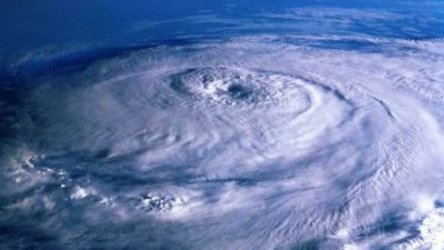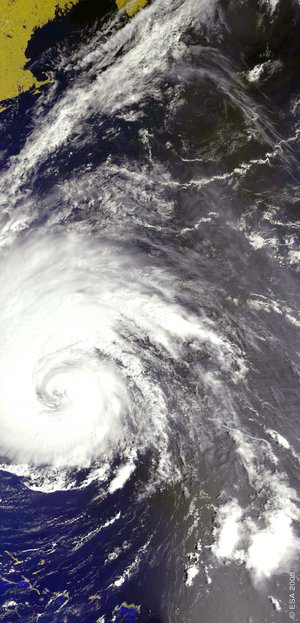A decade after launch, ERS-2's mission continues
Ten years and 52 289 orbits on from its launch, the Earth Observation mission of ESA's ERS-2 satellite continues with all instruments functioning well. A growing global network of ground stations is receiving data from the veteran spacecraft.
A solid decade of ERS-2 observations has helped cement a worldwide community of more than 3000 users. Demand for ERS-2 data is ever increasing, spurred on by the fact that the spacecraft keeps on updating its data archives as it orbits the Earth at more than seven kilometres a second.

When the Asian tsunami struck in December 2004, satellites provided rapid damage mapping. The continued availability of ERS-2 enabled the only change assessment via radar, complementing optical satellite views because radar can see through tropical clouds.
A new January 2005 ERS-2 high-resolution radar image of the Nicobar Islands north of Sumatra, near the epicentre of the tsunami, was combined with an archived image acquired in 1992 by sister spacecraft ERS-1.

The resulting multi-temporal composite highlights the stricken state of the islands' west coast. The composite was only possible due to the wide coverage of the 15-year combined ERS archive.
ERS-2 is also regularly utilised for disaster mapping during activations of the International Charter on Space and Major Disasters, which provides space-derived information to emergency responders.
ERS-2 acquisitions for InSAR analysis

The continuing availability of new ERS-2 images along with its archive is proving very useful for a technique called SAR Interferometry or InSAR. Growing in popularity, InSAR involves mathematically combining different radar images of the same spot to create digital elevation models (DEMs) and also revealing otherwise undetectable changes occurring between image acquisitions.
In effect InSAR works like a sophisticated version of 'spot the difference', identifying millimetre-scale ground movement to reveal urban subsidence, landslides or seismic motion – even the rhythmic 'breathing' of active volcanoes as they periodically inflate and deflate.

"The fixed geometry of the ERS-2 SAR provides a very consistent and reliable product, one which is proving to be highly beneficial for many interferometric applications and operations requiring frequent repeat data sets," says Professor Fabio Rocca of Politecnico di Milano. "The long time series of images means that new ERS-2 acqusitions are especially valuable for the analysis and monitoring of stable targets in urban areas."
ERS-based InSAR is increasingly being employed in this way for urban risk assessment. Some 200 European and Mediterranean towns are being surveyed as part of the initial activities for Global Monitoring for Environment and Security (GMES), a joint ESA and European Union initiative to create an independent global monitoring capability in support of European policy goals.
Near-real time results for weather forecasting and ozone monitoring

ERS-2 also carries a C-band scatterometer measuring ocean wind fields – the only instrument of its type currently in orbit, capable of making observations in the very heaviest of weather, even peering into the centre of hurricanes and typhoons.
Processed by the Royal Dutch Meterological Institute (KMNI), these unique data are assimilated operationally by users including the European Centre for Medium-Range Weather Forecasts, improving the quality of weather forecasting and short term 'nowcasting'.
Another ERS-2 sensor working in near-real time is its Global Ozone Mapping Experiment (GOME), delivering atmospheric global coverage of ozone, other trace gases, supporting operational services such as Tropospheric Emission Monitoring Internet Service (TEMIS), providing daily ozone, ultraviolet and air pollution monitoring.
"The GOME instrument on ERS-2 has given us more than we ever dreamed of," explains Professor Paul Crutzen of the Max Planck Institute in Germany, winner of the 1995 Nobel Prize for his work on ozone. "GOME has been a pioneer instrument. Such instruments are of great value for international negotiations on air quality and climate."
ERS-2's fall and rise

ERS-2 was launched on 21 April 1995, ensuring continuity of data from ERS-1, the first European Remote Sensing programme mission.
Back in 2001 the spacecraft was struck a blow as the last of its pointing gyroscopes failed. However all instruments were still functioning perfectly, so ESA engineers worked with industry to develop a new 'gyro-less' working mode to resume data delivery.
Then in June 2003 the onboard Low Bit Rate data recorder failed, used to store non-radar image data when out of touch with ESA ground stations. However, recognising the value of this data, international ground stations responded by working voluntarily to collect and distribute ERS-2 results in near-real time.

This week NASA's McMurdo Ground Station in Antarctica is set to begin acquiring ERS-2 data for the first time. The work is being carried out on a voluntary basis, displaying NASA's commitment to international cooperation.
The addition of McMurdo means that ERS-2 data are now being received across all seven continents. A new Beijing ground station is anticipated to come online by the end of this month.
Working with other spacecraft

Making up its other sensors, ERS-2's Radar Altimeter (RA) measures land, ocean and ice altimetry, while its Along Track Scanning Radiometer (ATSR) works like a space-based thermometer, taking the temperature of cloud tops as well as the sea surface – the best means of assessing the long-term extent of global warming – as well as surface land changes.
Since 2002, ESA's ten-instrument Envisat environmental satellite has also been monitoring sea surface temperature and atmospheric ozone as well as altimetry and radar observations.
However the stable and well-characterised nature of ERS-2 measurements make them extremely useful for synergistic cross-checking with Envisat for the time being, and for planned future missions such as CryoSat and MetOp.
"Simultaneous operation of ERS-2 and Envisat provides excellent and important opportunities to cross-calibrate and cross-validate the data from the two sensors," states Professor David Llewellyn-Jones of the University of Leicester, Principal Investigator of ERS-2's ATSR and the equivalent Envisat instrument.
"The difference in ERS-2 and Envisat overpass times of 30 minutes is providing opportunities for investigating diurnal variations in land surface temperature. This is important in the context of soil moisture, an important parameter for predicting vegetation development."
ERS-2's future

The spacecraft has been a key link in a chain of European and international missions to provide long-term observation of key environmental variables. The mission's well-defined products and services are playing an important role in initial services of GMES, and this is expected to continue until the new generation of operational Sentinel spacecraft are deployed.
Excellence of spacecraft and instrument engineering has led to a long service so far, and with its data still in high demand there may be yet more achievements to come.















 Germany
Germany
 Austria
Austria
 Belgium
Belgium
 Denmark
Denmark
 Spain
Spain
 Estonia
Estonia
 Finland
Finland
 France
France
 Greece
Greece
 Hungary
Hungary
 Ireland
Ireland
 Italy
Italy
 Luxembourg
Luxembourg
 Norway
Norway
 The Netherlands
The Netherlands
 Poland
Poland
 Portugal
Portugal
 Czechia
Czechia
 Romania
Romania
 United Kingdom
United Kingdom
 Slovenia
Slovenia
 Sweden
Sweden
 Switzerland
Switzerland
































